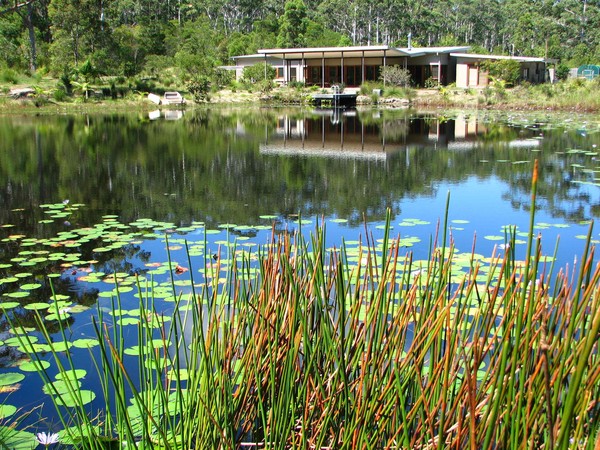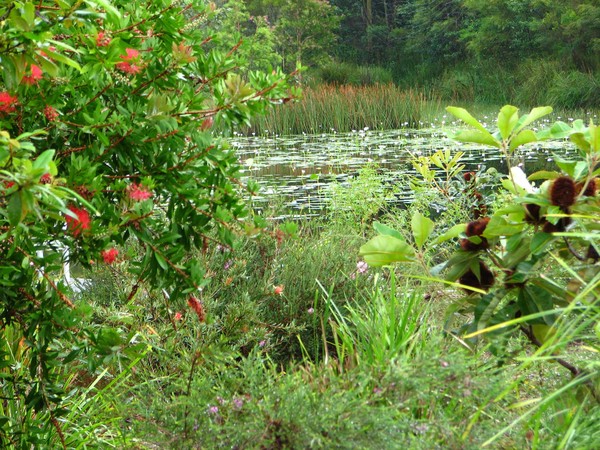Garden Design Study Group: Rowland Garden
Pacific Palms, New South Wales
In 2002, we sold our Sydney house of 19 years and bought 10 hectares (25 acres) of partly cleared wet-sclerophyll forest adjoining Wallingat National Park at Pacific Palms on the mid north coast of New South Wales. It was one big step towards the vision we shared: an eco-friendly house and garden in harmony with nature. We hired a local earthmover to upgrade the forest track to a driveway; excavate a lagoon/wetlands and a safe spillway downstream from the wide swamp/slow-moving creek crossing the property; adjust creek entry from upstream to prevent run-off and siltation; and extend the treed knoll to create an island retreat for birds about 600mm above water level to escape flooding. We specified varying water depths, from 200mm for wading birds to six metres for diving birds, and as a retreat for native fish during periods of high temperatures and low water levels.
After completion of the lagoon and driveway in December 2003, we hired an eco-aware local builder, the Sugar Creek Building Company’s Bruce Brown. Bruce’s team laid the foundations in July 2004 and completed the house in March 2005. We have since revegetated with about 2000 local native trees and shrubs, mainly scattered along previously cleared sections of the north and south boundaries. These provide wildlife corridors into Wallingat National Park and screening from neighbouring properties.
In 2006, we turned our attention to the gardens, starting with the south-facing front entrance garden. After deep ripping the clay base, compacted during construction, we mixed the stockpiled clay-loam topsoil with grit, horse and chicken manure and worm castings, and then re-laid it. After we’d spread a coarse mulch layer and lined the creek with crushed rock and pebbles, we installed our first garden plant, Cyathea cooperi (scaly tree fern) next to the creek. Since then, we’ve installed many more plants, with more to come during the next few years. To impart a relaxed ambiance and sense of unity, and for ecological integrity, we plant mainly local and bio-regional species. These all thrive without chemical fungicides or insecticides and attract many native songbirds including birds that feed on insects. With such an abundance of insectivorous birds and frogs, we are seldom bothered by mosquitoes.
We’re both passionate about uniting aesthetics with biodiversity and conservation and we seize every opportunity to promote a wider, deeper appreciation of local and regional natural heritage. Our aim is to leave a legacy of timeless beauty for our children, our children’s children and future generations of Australians.
Gordon and Marie Rowland
Gordon Rowland is managing director of Indigenous Landscape Design Australia; Marie Rowland its researcher.
* * * * * *
For more information on this garden see Garden Design Study Group Newsletter 87, August 2014, p. 4-6




 Australian Native Plants Society (Australia)
Australian Native Plants Society (Australia)